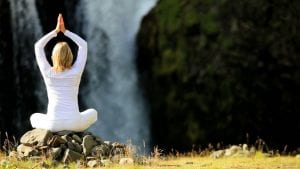 One of the foremost yoga teachers in the world, B.K.S. Iyengar, said, “The body is your temple. Keep it pure and clean for the soul to reside in.”
One of the foremost yoga teachers in the world, B.K.S. Iyengar, said, “The body is your temple. Keep it pure and clean for the soul to reside in.”
As a yoga guru, yoga was naturally the focus of his thoughts.
Yoga is a combination of physical, mental and spiritual practices that originated in ancient India, probably in the 5th or 6th centuries BCE. With Indian Hindu monks successfully penetrating the philosophical societies of the West in the late 19th and early 20th centuries, yoga gurus thereafter, found it easier to negate the bohemian stigma once attached to yoga, and ensure acceptance and respectability of yoga practice in Western communities.
The National Health Interview Survey (NHIS) of the National Institutes of Health (NIH) in the US, in a recent survey found that around 21 million adults (nearly double the number from 2002) and 1.7 million children practice yoga in the US. Among Americans between the ages of 18 and 44, the numbers practicing yoga nearly doubled since 2002. The number of older Americans between the ages of 45 and 64 getting into yoga practice increased percentage-wise from 5.2% in 2002 to 7.2% in 2012. About 400,000 more children between the ages of 4-17 engaged in yoga practice in 2012 than in 2007.
So what do people understand about yoga? “Yoga” means “to yoke” or to bind – a process that connects and balances the body, mind, and breath. This is, in fact, the essence of yoga, not merely the physical practice itself, as is generally believed. Physical balance allows the body to maintain a particular posture without falling. Mental balance brings inner peace and harmony, however turbulent the environment the person is in. The yoga lifestyle enables physical and mental balance essential for a healthy, fulfilling life.
One person may find a room full of sweaty bodies in a yoga class energizing and exhilarating to be with like-minded people. Another person may find the same situation distracting, and would prefer to do yoga exercises in the privacy and quiet of their own living room. It depends on what helps each person to regain balance, and the yoga lifestyle teaches physical and mental balance as a way to achieve a healthy and fulfilling life.
As breath means life, focus on breathing is a fundamental in yoga practice. Exhaling spent air, and filling the lungs with oxygen-rich fresh air, energizes the whole being, opening heart and mind to greater possibilities of commitment to life decisions. The breathing techniques or pranayama together with meditation and the physical workout become a holistic fitness package.
A main point in yoga is the focus into oneself. Most of our waking hours, our attention is on external issues, with no time to focus on what is happening within us. Yoga fills this need when the day’s work is done. It reminds us that we need to pause a moment the take stock of ourselves and to keep our minds on the present moment. It makes us give attention to how our bodies feel, the quality of our breath as air fills our lungs and the focus of our mind as we make our thoughts all about the present moment. A certain serenity pervades the whole of ourselves, releasing stress and making us peaceful. It is the same kind of calm that you would feel by gazing out at the ocean seated on a sun-kissed beach. The feeling of peace and the absence of bruising thoughts helps rejuvenate the body – a discovery that keeps leading more and more people to embrace the health-giving practice of yoga.
With more Americans becoming enthusiastic about yoga, more of them are rolling out their yoga mats. Choosing the right type of yoga mat is important as it is symbolic of what the person is seeking in practicing yoga – like the space the mind seeks through the body. The yoga mat needs a good grip and adequate padding to make the yoga session bring a sense of release and calm to a person pummeled by the worries and stress of daily living.
The next consideration, probably the most important, would be to choose the right yoga clothes. A yoga shop can help you select comfortable, breathable clothing needed for a productive yoga session. The most important consideration in the choice of clothing would be comfort and the ability to move freely without being constrained by awkward designs. Browsing around among yoga clothes helps people understand what type of clothing would best suit them in what will be an intensely personal experience of seeking physical and mental balance in a restless, turbulent world.
Known as the “poetry of movement,” yoga becomes a balancing of holding on and letting go, just like life itself. It makes for a flexible human being able to meet the challenges of life head-on. As the Japanese proverb says, “The bamboo that bends is stronger than the oak that resists.”
If you would like to contribute an article or contact our contributors, you can get in touch here
